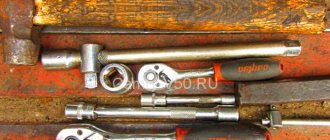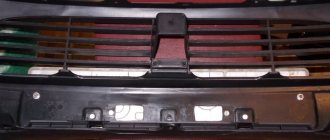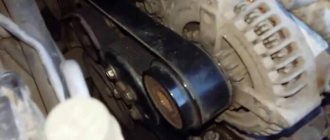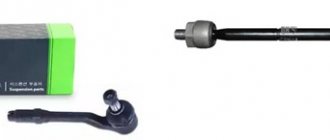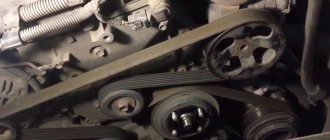A worn timing belt can cause your Toyota Corolla to stall in the middle of the highway. Or the car won't start at all. To avoid this, it is necessary to change the timing belt on time.
But at a service station, if the belt still appears to be in order, the car owner has no desire to go, and he can wait until the mechanism fails completely. However, the issue can be solved much more simply and an ordinary car owner, even a novice, will be able to independently choose and replace the timing belt on a Toyota Corolla.
When to replace a device immediately
Attention! Experienced mechanics recommend that maintenance be performed once a year. During the maintenance procedure, defects or minor changes will be discovered that will require intervention and replacement of faulty mechanisms.
However. If a car owner, for various reasons, cannot visit a specialized service station, then he needs to pay attention to the following timing belt defects and eliminate them:
- the lifespan of the belt part, as stated in the instruction manual, has expired;
- the appearance speaks for itself that it needs to be replaced;
- cracks or mechanical damage appear and there are more of them each time;
- oil marks on the belt. It will be necessary to find and eliminate the cause of the lubricant leak;
- detachment of the top layer, cord.
In these cases, replacing the Toyota Corolla timing belt is done immediately.
Another nuance that many new car owners do not pay attention to. The manufacturer recommends changing the belt once every 150,000 km. The novice driver read it and forgot it until this number is displayed on the dashboard monitor.
This is absolutely impossible to do. When a manufacturer tests a car, it assumes easy operating conditions in its country or in Europe, the United States of America. In Russia, roads differ from European ones for the worse, especially in urban-type settlements and villages. Natural conditions: long frosty winters, snow piles, slippery roads, hot summer seasons in the southern regions of the Russian Federation also make their negative contribution.
Such operating conditions are called extreme. As a result, the belt part wears out much faster than the period specified by the manufacturer. Therefore, Russian suppliers strongly recommend making allowances for the conditions in which the machine is used. Or rather, change the timing belt after 90 thousand kilometers.
Choosing a new belt
When choosing a new belt, you should first of all pay attention to the products of the Belgian company Gates and the German Conitech . Both companies specialize in the production of automotive components and their products are directly supplied to the assembly lines of many auto giants. Their products boast traditionally high quality, but their prices are somewhat inflated. Products from Italian Dayco and German Bosch are no worse and boast more affordable prices.
When purchasing a new belt, as with any other components, it is best to contact an authorized dealer. There are several subtleties worth noting here. The so-called “original” parts are essentially the same belts, say from Bosch, on which the car brand was applied, not the manufacturer. This is such a clever trick by the official dealer to make you pay 30 - 50% more. Some motorists believe that “original” parts are of better quality, but this is not the case. They are no different
“Then why go to an official dealer if it’s more expensive?” This way you will protect yourself from fakes. Modern bootleggers have become so successful in their craft that even experienced sellers cannot always distinguish the original from a fake, not to mention ordinary motorists. Fake belts are often made from low-quality materials that simply cannot withstand loads and constant temperature changes. Such a part will deteriorate very quickly and burst at the most inopportune moment.
What additionally changes with the belt?
Toyota Corolla stopped installing a timing belt in 1998. Therefore, vehicles manufactured earlier than this year have a chain. And the belt was installed only on cars with a 4 A FE engine.
The following components are replaced along with the belt:
- front crankshaft oil seal;
- spark plug well seal;
- antifreeze pump.
It should be noted that the chain changes less often than the belt part. And the symptoms of its malfunction, which should make car owners wary, can be such as noise, the clanging of a metal mechanism when the engine is running.
What's next?
Next comes the verification process, which takes some time, but this is where composure and attentiveness are required.
So, first of all, we check the accelerator rollers and tensioner. While turning the rollers, we listen to the noise of the bearings. Then we inspect the pulley: it should not be dirty and should look smooth upon visual inspection. Next, check the fastening of the accelerator roller. Having lubricated the removed pulley lever, we put it in place and proceed to installing the damper roller. Check the tensioner for possible oil leaks.
REMEMBER that it is IMPOSSIBLE to replace the tensioner if there is an oil leak!
Next we go through the reverse process - this is assembly. Same process in reverse. We will not dwell on this process in detail now. By briefly talking about the disassembly process, we tried to hint to you that this process is easy only on paper. In fact, the execution of such work must be trusted to the masters. After what may seem like successful independent work, very serious troubles may arise.
Belt replacement instructions
Steps for the guide “Replacing the Toyota Corolla timing belt” (we're talking about the belt):
- Since the wires from the battery terminals have already been removed, all that remains is to stop the car. Place locking stones under the rear wheels. Raise the handbrake.
- Remove the nuts from the front right wheel and jack up the car.
- Remove the wheel and remove the plastic frame.
- Disconnect and move the windshield washer reservoir to the side.
- Remove the spark plugs.
- Remove the engine valve cover.
- Disconnect the drive straps.
- Remove the air conditioning compressor drive roller. Remove the actuator if the car is equipped with cruise control.
- Raise the motor using a wooden stand.
- Align the mark on the crankshaft pulley with “0” on the lower cover of the gas distribution mechanism.
- Secure the flywheel.
- Unscrew the crankshaft pulley bolt.
- Remove the plastic protection from the timing belt.
- Disassemble the guide flange.
- Loosen the tensioner shaft. Press it in and tighten. The belt should now come off the roller easily.
- Unscrew the nuts on the mount at the bottom of the motor, and unscrew the screw on top.
- Lower the Toyota Corolla engine and remove the part.
- Release the drive gear from the mechanism.
Now you will need to clean the area where the strap goes. Put it on and install everything in reverse order.
Consequences of untimely replacement
Failure to promptly replace the timing belt can lead to very disastrous consequences for the car. Wear of a part leads to a decrease in the dynamic characteristics of the vehicle and can cause additional malfunctions.
Early or late, a worn or damaged part may rupture. During a break, desynchronization of the pistons and valves occurs. As a result, the valves begin to hit the pistons, which leads to bending of the valves and deformation of the piston heads. In addition, if it breaks, the belt tends to wrap around the generator pulley, blocking the crankshaft, which leads to additional breakdowns. Repairing these components, as you can imagine, will cost you a pretty penny.
Replacing the chain on modern Toyota Corolla engines
The procedure for replacing a chain is more complex than the process of changing a belt part, although in some respects it is similar. If the car owner does not have the skills and does not know the principle of operation of the engine and its structure, then it is better to leave this work to experienced mechanics.
Replacement steps:
- The battery terminals are removed, the car is on the handbrake. This is a mandatory rule and the first action.
- Remove the air filter device.
- Remove valve protection.
- Install the engine according to the marks prepared by the manufacturer. The marks on the sprocket and the motor housing must match.
- And the mark on the pulley should coincide with the bottom.
- Move the ratchet to the side so that it does not interfere.
- Crank the engine with a flat wrench.
- Remove the wires from the ignition coils.
- Turn on the starter.
- Remove the crankshaft pulley. Remove the front motor cover.
- Unscrew, but do not remove the tension shaft bolts, remove the shaft itself.
- Remove the auxiliary shaft sprocket.
- Remove the chain and install another one.
Reassemble all components in reverse order when the chain is replaced. Before this, you need to check the stars for play. If they are loose, replace them.
Attention! Put on both the chain and the belt only when you are sure that all the marks match. Otherwise, the motor may be damaged.
A small educational program
The driver must know when the timing belt needs to be replaced.
- When starting the power unit, a knocking sound appeared.
- If you feel that the engine is running intermittently, it is unstable.
It is these signs that indicate that it is time to visit a Technical Service Station and not delay this issue in order to avoid more serious problems with the power unit.
Replacing the timing belt should be carried out by experienced craftsmen using modern equipment. The belt is being replaced:
- Planned.
- Unscheduled.
Replacing the timing belt on a Toyota Corolla
The timing belt is responsible for the quality operation of the engine, and it is with its help that the gas distribution mechanism of the internal combustion engine is driven. The mechanism, in turn, promotes the correct supply of the fuel mixture to the cylinders, then removes combustion products. When the engine is running, the timing belt is in constant motion, performing a transfer function. Replacing the timing belt on a Toyota Corolla is an important routine procedure.
A broken structure can negatively affect the operation of the gas distribution system, as well as improper operation of the pistons and valves. This type of breakdown can lead to costly repairs.
The belt driving the entire system is made of high-quality materials, and the safety margin is designed for long kilometers.
Read also:
- How to change the fuel filter on a Toyota Camry with your own hands
When to change the belt?
High-strength materials are not able to protect and maintain the integrity of the belt under high mechanical loads. Therefore, wear of the timing belt is inevitable and sooner or later a scheduled update (replacement) will have to be carried out. The recommended safety margin for consumables is about 60 thousand kilometers. But keep in mind the fact that replacement must be done much earlier before the timing belt experiences complete wear. An update at 45-50 thousand kilometers would be more correct and calmer. This is exactly the mileage when the belt will be in working condition, but not “fresh”.
Timing belt for Toyota Corolla 2008
If the car owner did not pay attention to the scheduled replacement of consumables, there are two main criteria that will help determine problems with the timing belt:
- When the engine starts, a knocking noise will be heard,
- The internal combustion engine operates intermittently.
If a problem occurs based on the above criteria, you must immediately go to the nearest car service center or service station. There is no need to delay this type of breakdown!
A complete replacement of the timing belt should be carried out by experienced specialists and using professional equipment.
Replacing the timing belt - do it yourself
You can update the gas distribution mechanism consumables yourself in order to save money. First of all, we ask ourselves the question: “What will outweigh price or quality?” Most often you want to make a “knight’s move” - buy a belt and carry out the update yourself. It is, of course, better to replace the Toyota Corolla timing belt in a specialized center in order to avoid complicated and incorrect installation. And we recommend that you put quality, not savings, first.
If replacing the belt in the gas distribution system is carried out independently, then you need to perform the entire process sequentially and step by step. To carry out the work you will need to have a certain set of tools.
Step-by-step instructions: changing the timing belt on a Toyota Corolla 2008
Procedure for removing the belt
More on the topic:
- How to choose the right auto parts
- The car must be on the parking brake (handbrake).
- Unscrew the right front wheel nuts.
- Secure the car in a raised position using stands.
- Remove the right wheel and unscrew the front bumper liner.
- Remove the spark plug cap, disconnect the battery terminals and high-voltage wires.
- We unscrew the spark plugs.
- We move the expansion tank to the side for easy access.
- We dismantle the drive belts and the intermediate roller of the air conditioning mechanism.
- Remove the cylinder head cover.
- We install the piston of the first cylinder to the “top dead center” (TDC) position of the compression stroke.
- We fix the flywheel so that it cannot turn.
- Unscrew the “protective” timing cover.
- Using a wrench, loosen the adjusting nut and move the roller to directly remove the belt.
- To completely replace and remove the belt, you need to unscrew the two nuts securing it to the body.
- We take the timing belt out of the engine compartment.
It is important to pay attention to belt wear and damage. Also perform a detailed inspection of the gear. If there is dirt, remove it. Check the front crankshaft oil seal. After removing the belt, do not rotate the camshaft or crankshaft (in special cases, if you need to set the coincidence, then a rotation of a few degrees is allowed, but no more).
Carrying out adjustment work
When dismantling the timing belt, check its wear. A “normal” appearance does not mean that the belt is ready for further use. The outside should be free of cracks or noticeable wear. The inner side should be free of delamination or wear of the teeth. If you notice at least one such problem, then the Corolla timing belt is no longer suitable for subsequent use and requires replacement.
Another stage of diagnosis and adjustment is checking the tension roller and its spring. Loosen the tensioner and rotate the roller, determine its rotation. Then remove the spring and check for wear (if the spring is stretched, it needs to be replaced).
For the Toyota Corolla 1.3 engine, replacing the timing belt requires additional inspection, namely, we focus on the pulley. If there are obvious signs of timing wear, it is recommended to replace the upper intermediate pulley.
The procedure for performing work on installing the timing belt
- We perform high-quality cleaning of all system elements (we prepare for installation).
- We check the marks of the camshaft and crankshaft, it is necessary that they are set to their original position and correspond to the “top dead center” (TDC).
- Install the belt on the gears.
- We secure the lower belt cover and the upper crankshaft pulley so that the TDC marks coincide.
- We tension the belt from the front side of the car (loosen the tensioner roller and turn it half a turn).
- Smoothly turn the crankshaft two turns clockwise.
- We tighten the tensioner so that it coincides with the specified torque.
- We check the tension of the timing belt (the deflection coefficient must coincide with the standards).
- Then we check the TDC matching marks (if they do not match, then repeat the procedure for installing the belt again).
- Install all other parts in reverse order.
This completes the installation of the Toyota Corolla timing belt. It is strongly recommended not to start the engine until you are absolutely and completely sure that the consumables have been updated correctly. A belt break can occur due to poor cleaning of the elements on which the timing belt is attached or due to high tension. If the set TDC marks do not match, then starting the engine under such conditions can cost you a pretty penny.
Preference to quality and “refusal” to saving
Location of the belt and rollers on the Toyota Corolla engine
Of course, we are not against replacing the timing belt on a Toyota Corolla ourselves. But it's up to you to decide. I would like to give preference to a more expensive option - replacement at a car service. At the same time, be confident in the quality and correct installation of the timing belt.
When starting the power unit with an incorrectly installed belt, the valves may bend. There is also a chance that the engine will misfire. Elementary negligence or the slightest mistake can be the consequence of long engine repairs and large financial costs.
And what's better? After replacing it yourself, you still need to contact specialists and pay them money. It is better not to delay replacing the timing belt on a Toyota Corolla, but to contact specialized centers for a scheduled update of the gas distribution mechanism consumables.
Video: instructions for replacing the timing belt on a Toyota Corolla ( Toyota Corolla )
Read also:
- We replace the air filter of Toyota Rav 4 (Toyota Rav 4)
- Replacing the Toyota Corolla oil filter. We do it ourselves
Direct signs of a faulty timing belt
- Critical wear of the belt tensioner or its rollers (can be seen by removing the valve cover);
- Worn sprocket teeth (can be seen by removing the valve cover);
- Cracks and other signs of wear and damage.
If you notice the appearance of at least one of the described signs of malfunction, you must immediately check the condition of the timing belt. Experienced car owners can easily do this on their own, but it is better to carry out this procedure at a service station.
At a car service center, a specialist will be able to do a full inspection of the timing belt, check its tension and identify the degree of wear. If necessary, immediately adjust or replace it with the necessary components. Only an experienced specialist at a service station will be able to correctly tension the belt, because a weakly tensioned belt is more at risk of breaking.
Depending on the specific Toyota brand, our specialists perform a number of procedures that allow:
- check the degree of tension of the timing belt;
- carry out a visual inspection of the entire length of the belt;
- inspect the condition of its teeth;
- identify cracks and other signs of wear
- Identify and eliminate the causes of contamination of the timing system with coolant or oil.
It's time to change the timing belt or you notice signs of a faulty belt, do not delay your visit to a car service center, otherwise the consequences may be unpleasant.

